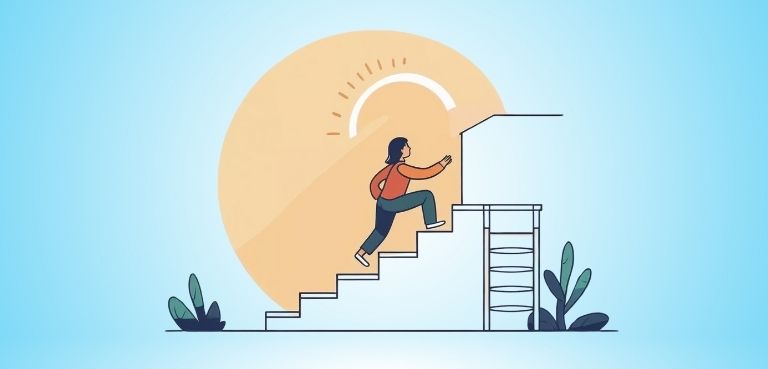You grow faster when you build life skills and work skills together. That’s the point. This Personal and Professional Development Guide explains the difference, shows the overlap, and gives you one plan you can start today.
What is personal and professional development?

Personal development builds habits and life skills that support your goals. You shape health, focus, confidence, and relationships. Professional development builds role skills and career assets. You learn key tools, deliver better work, and collect proof you can show.
Personal outcomes: steadier sleep, calmer days, sharper focus.
Professional outcomes: faster delivery, cleaner handovers, stronger reviews.
Why is personal and professional development important?
Growth lifts confidence and output across your week. Better habits speed up learning and reduce stress. New skills raise your impact and open new roles. Teams gain from steady learning and fair feedback. People stay longer when growth feels real and shared.
How are personal and professional development linked?
Personal habits power faster learning at work. Work wins build pride and energy at home. You create a loop when you support both. Autonomy, competence, and close bonds fuel that loop. Protect those three drivers each week.
Personal vs professional development
Personal growth targets identity, mindset, and daily routines. Professional growth targets role outcomes and the proof you earn. Both depend on feedback, clear goals, and honest reviews. You should not pick one and ignore the other. Balance both every quarter and adjust with care.
Myths to drop: “Learning styles” don’t guarantee better results. Certificate collecting without practice rarely helps.
What is personal development?
Shape your days around long-term goals. Strengthen resilience, deepen self-awareness, and nurture meaningful connections. Finally, set healthy boundaries and preserve your energy for what matters most.
Examples of personal development
Train a steady sleep routine and protect calm starts. Block deep work four times each week and guard those hours. Journal for ten minutes each night and review wins. Raise listening in meetings and ask one clear question. Walk each morning before you check your phone. Tidy your budget and track spends every Friday. Practice calm breathing before tough calls. Plan meals on Sundays to cut food stress.
Try this: Pick a trigger, a routine, and a reward. Tie your habit to that trigger. Track one streak at a time.
Tips for personal development
Choose one theme for the next quarter and keep scope small. Link each habit to a reliable daily trigger. Track streaks in one sheet and review every Sunday. Ask a buddy to hold you to your plan.
What is professional development?
You grow your craft through projects that challenge you. You master the tools that matter, build a portfolio, connect with mentors, and join valuable networks.
Examples of professional development
Automate one report with a new tool and log time saved. Shadow a senior for two sprints and copy one good method. Publish a short case study that shows problem, action, and result. Earn a recognised certificate that maps to real tasks. Present lessons at a meetup and invite questions from peers. Coach a new starter and improve your own method. Write a clear SOP for a key task and share it.
Portfolio ideas: Record a quick walkthrough. Capture before and after notes. Show impact with one number.
Tips for professional development
Set two OKRs for the quarter and review them weekly. Pair every course with a live project so you apply ideas. Book monthly one-to-ones for feedback and act on it. Ask one mentor for guidance and share your plan first.
Self-Reflection and Assessment
You need a clear view before you choose goals. Score strengths and gaps, then match them with your role demands. List values that guide choices so your plan fits your life.
SWOT for personal and professional growth
Write top strengths and key weaknesses on one page. Spot opportunities you can reach within three months. Note threats that could block progress and plan one fix.
Mini self-assessment: Rate focus, energy, tools, feedback, support, time, confidence, and network. Low personal scores? Fix habits first. Low work scores? Plan projects now. Map key skills in a simple Skills Matrix. Note current level, target level, importance, and gap. Set a due quarter and an owner.
Goal Setting
Goals turn ideas into action and stop drift. Keep goals simple, dated, and easy to measure. Two to four goals work well for most people.
SMART goals (vs OKR) for development
You will see both terms online, so let’s define them. SMART means Specific, Measurable, Achievable, Relevant, Time-bound. Use SMART for habits that need daily effort. Example: “Walk 7,000 steps every day for 90 days.” OKR means Objective and Key Results. Use OKRs for outcomes that need several moves. Example Objective: “Cut month-end prep time.” Key Results: “Automate two steps by week six.” “Publish a new SOP by week eight.” “Halve the total time by Q4.”
By persona:
Student SMART: Revise 45 minutes, four nights a week. Student OKR: Publish two portfolio pieces by June.
IC SMART: Two deep-work blocks before noon, four days a week. IC OKR: Automate monthly report and halve prep time.
Time Management
Time choices shape every result in your week. Plan focus, learning, and recovery blocks and protect them.
What Is Time Management?
Plan your week before it starts and rank tasks by value. Match hard work with your best hours and avoid context shifts.
Eisenhower Matrix (urgent vs important)
Sort tasks into four boxes and act with intent. Do urgent and important work first. Schedule important work next. Limit or drop low-value tasks.
Weekly flow: Turn off alerts during deep work. Batch admin in one short block. Leave space for surprises.
Skill Enhancement
Use three moves each week to build skills. Do real work that stretches you and log the lesson. Ask a mentor for feedback and test one change. Take a short course to fill a gap and then apply it.
Mentor outreach tip: Keep your message short, kind, and clear. Share your goal, your plan, and your ask.
Balancing Personal and Professional Life
Balance keeps your mind fresh and your work sharp. Set clear limits for work hours and switch off at a set time. Plan rest, movement, and time with people who matter.
Work-life Balance
Pick non-negotiables for sleep, food, and family time. Turn off alerts after hours and protect your wind-down. Book short breaks and move your body each day. Say no when capacity runs low.
Top 7 Skills Needed for Personal and Professional Development
Time management helps you plan and deliver. Communication helps you explain and align. Active listening builds trust and cuts noise. Emotional intelligence helps you read the room. Problem-solving helps you find causes and test fixes. Leadership helps you set a path and guide others. Organisation skills keep work tidy and fast. Self-confidence helps you act in public. Adaptability helps you move with change. Decision making helps you progress when facts stay unclear.
1. Self Confidence
Confidence grows when you act and learn aloud. You build it by doing, not by waiting.
- How Confident Do You Seem to Others: Notice your tone and pace when you speak. Hold a steady stance and make fair eye contact. Ask for direct feedback and act on one point.
- Confident Behavior: Speak in clear statements and explain your reasons. Admit mistakes, fix them fast, and share the lesson. Ask strong questions and seek stretch work when you can.
- Behavior Associated with low Self-Confidence: You dodge hard tasks and wait for a perfect time. You hide errors and reject praise. Catch those signs early and take one brave step today.
- Confidence reps: Record a one-minute pitch and watch it back. Run mock interviews with a friend and swap notes. Share wins and lessons in a short team post.
2. Communication Skills
Great communication lifts every part of your work. You listen first, then share clear points with care.
- Listening: Give full attention and park your phone. Reflect key points back to check meaning. Ask one short question that moves things forward.
- Nonverbal Communication: Use open body language and a calm tone. Match your face with your words and avoid mixed signals.
- Clarity and Concision: Cut filler words and aim for short, direct lines. Lead with the point, then support it with one fact.
- Friendliness: Greet with a smile and use names with care. Thank people for help and follow up when needed.
- Confidence: State your view without fluff and hold a steady pace. Finish with a clear ask so people know the next step.
- Empathy for others: Name the feeling you see and ask how you can help. Adjust your plan with care when new facts appear.
- Open-Mindedness: Invite other views and test ideas you did not suggest. Change course when better data appears and explain why.
- Respect: Arrive on time, keep promises, and credit people in public. You build trust when you do these three things.
- Feedback: Ask for one thing to improve and then act on it. Offer one praise point and one next step when you coach.
- Picking the Right Medium: Use chat for quick notes and email for detail. Use video or in-person time for hard topics.
3. Emotional Intelligence
Emotional intelligence helps you read yourself and others. You then choose words and actions that fit the moment.
Characteristics of Emotional Intelligence
You stay aware under stress and keep a steady mood. You show drive, empathy, and social ease that helps teams.
- Self-Awareness
- Self-Regulation
- Motivation
- Empathy
- Social Skills
Score each area on a simple scale. Pick one to train for a month.
How to Improve Your Emotional Intelligence?
Run a daily check-in and note your triggers. Practice calm breaths and log one win. Reflect each week and choose one change.
4. Active Listening
Active listening helps people feel heard and safe. You gain facts, build trust, and avoid wrong turns.
Becoming an Active Listener
Face the speaker and show that you follow. Paraphrase key points, then ask one clear question.
- Pay Attention
- Show That You’re Listening
- Provide Feedback
- Defer Judgment
- Respond Appropriately
Let people finish before you reply. Avoid quick judgements. Share your view after you reflect.
5. Leadership
Leaders paint a clear picture and guide teams with care. They turn goals into plans and keep people on track.
- Becoming a Better Leader: Write a simple vision and share it often. Tie tasks to that vision and remove blockers quickly.
- Creating an Inspiring Vision of the Future: Use plain words and explain who benefits. Show milestones and a clear path to reach them.
- Motivating and Inspiring People: Spot good work fast and share wins each week. Remove friction and make progress easy.
- Managing Delivery of the Vision: Split work into clear chunks and track progress. Review often and adjust when facts change.
- Coach and Build a Team to Achieve Your Vision: Run monthly coaching chats and ask more than you tell. Grow people through projects and celebrate progress.
6. Problem-Solving
You fix issues with a simple, honest method. You focus on causes and test small, safe steps.
- Defining the Problem: Write the problem in one line and confirm with users. Check facts before any move.
- Understanding Complexity: Map the parts on one page and mark links. Choose one loop to test and measure the effect.
- Affinity Diagrams: Group ideas by theme and name each cluster. Pick a theme to explore and design a small test.
1. Simplex
2. Appreciative Inquiry
3. Soft Systems Methodology
Choose the method that fits your case. Follow steps and capture lessons for the next round.
7. Organisation Skills
Plan your day the night before and keep a short list. Batch admin work and delegate when it makes sense. Reset your space each Friday and start Monday with focus.
Be Proactive
- Make a list
- Make a schedule
- Be an early bird
- Establish a filing system
- Make the most of your prime time
- Minimise interruptions
- Learn to delegate
- Organise your workplace
Book prime hours for deep work and protect them. Turn off alerts during those blocks. Keep files tidy and easy to find.
Personal and Professional Development: How to See Results
Use a six-step loop that keeps change simple. First, run a quick self-audit with your Skills Matrix. Second, set two to four goals and keep them tight. Third, design a 70-20-10 mix and bias to practice. Fourth, block time for deep work and weekly learning. Fifth, track habits and outcome metrics that match goals. Sixth, review weekly and reset plans each month.
New Frontiers in Personal and Professional Development
Remote work reshaped how teams learn and share knowledge. Digital skills now support most roles, not just tech. DEI skills help every team work better and move faster. Wellbeing and energy management sit at the core of strong work. Side projects and small ventures also build rare skills and proof.
Embracing the Future of Personal and Professional Development
Stay curious and flexible as tools and roles change. Test small ideas, learn fast, and share lessons with your team. Keep your plan light so you can move when chances appear.
Personal and Professional Development Guide: How They Connect
Personal goals power focus and drive at work. Work goals give you proof and confidence in life. Plan both together and keep score.
Key Takeaways for Your Development Journey
Join life skills and work skills in one clear plan. Set small goals and bias to practice. Ask mentors for help and give help in return. Track habits and results, then adjust without guilt. Review monthly and keep going.
How do we know if we have an engaged workforce?
You see steady learning and clean goals across teams. People share wins and lessons and ask for feedback. Churn drops because growth feels fair and real.
Cultivating a culture of people development
- Invest in training and development opportunities: Give each person a fair budget and a plan. Support peer learning and shadow days.
- Identify your skills gaps: Run short skills checks each quarter and review themes. Fix gaps that block delivery first.
- Personal and professional development — create a follow-up plan: Book a chat after each course and ask for one action. Check impact the next month.
- Make development an ongoing process: Set a clear cadence and publish a simple calendar. Hold monthly reviews and share good practice.
Personal and Professional Development Guide
Ask ten quick questions and score focus, habits, and role skills. Pick one theme to start this quarter and link your goals. Use the Skills Matrix to set level, gap, and due quarter.
Enrol today. Join our online personal development courses and professional development courses at School Of Health Care. Learn with friendly tutors, build real skills, and grow your career with confidence.



